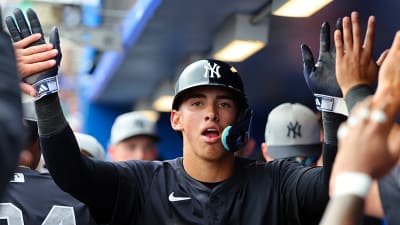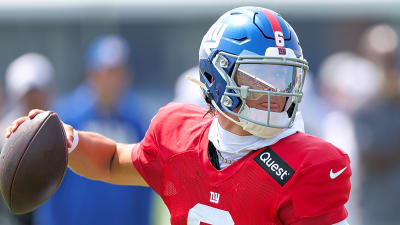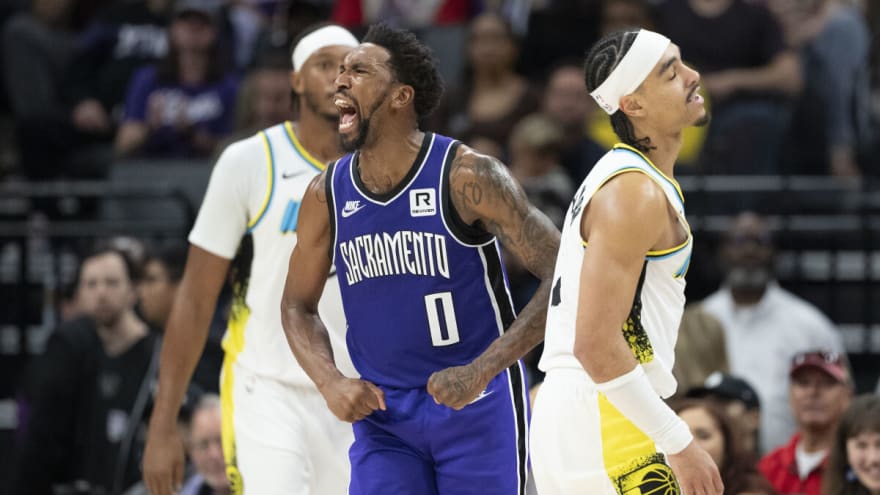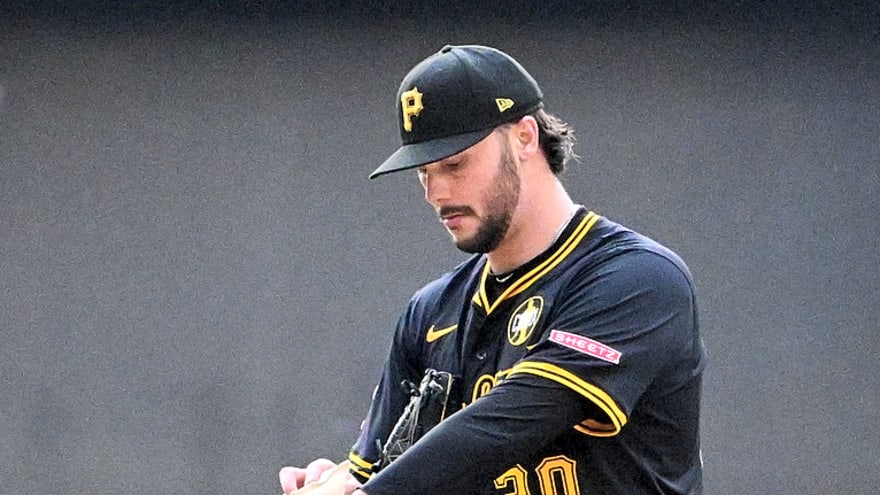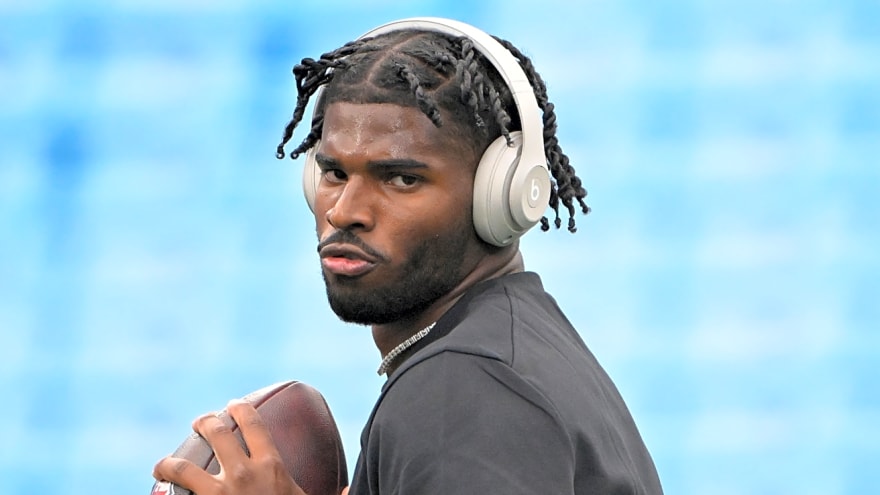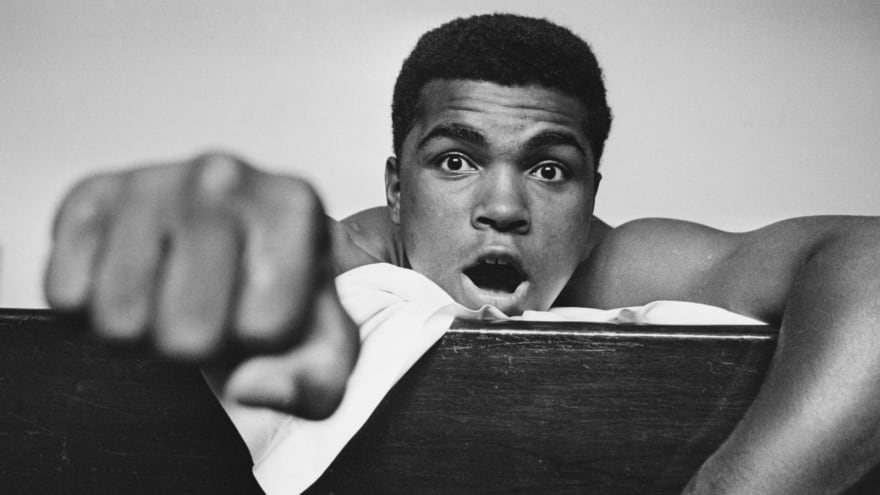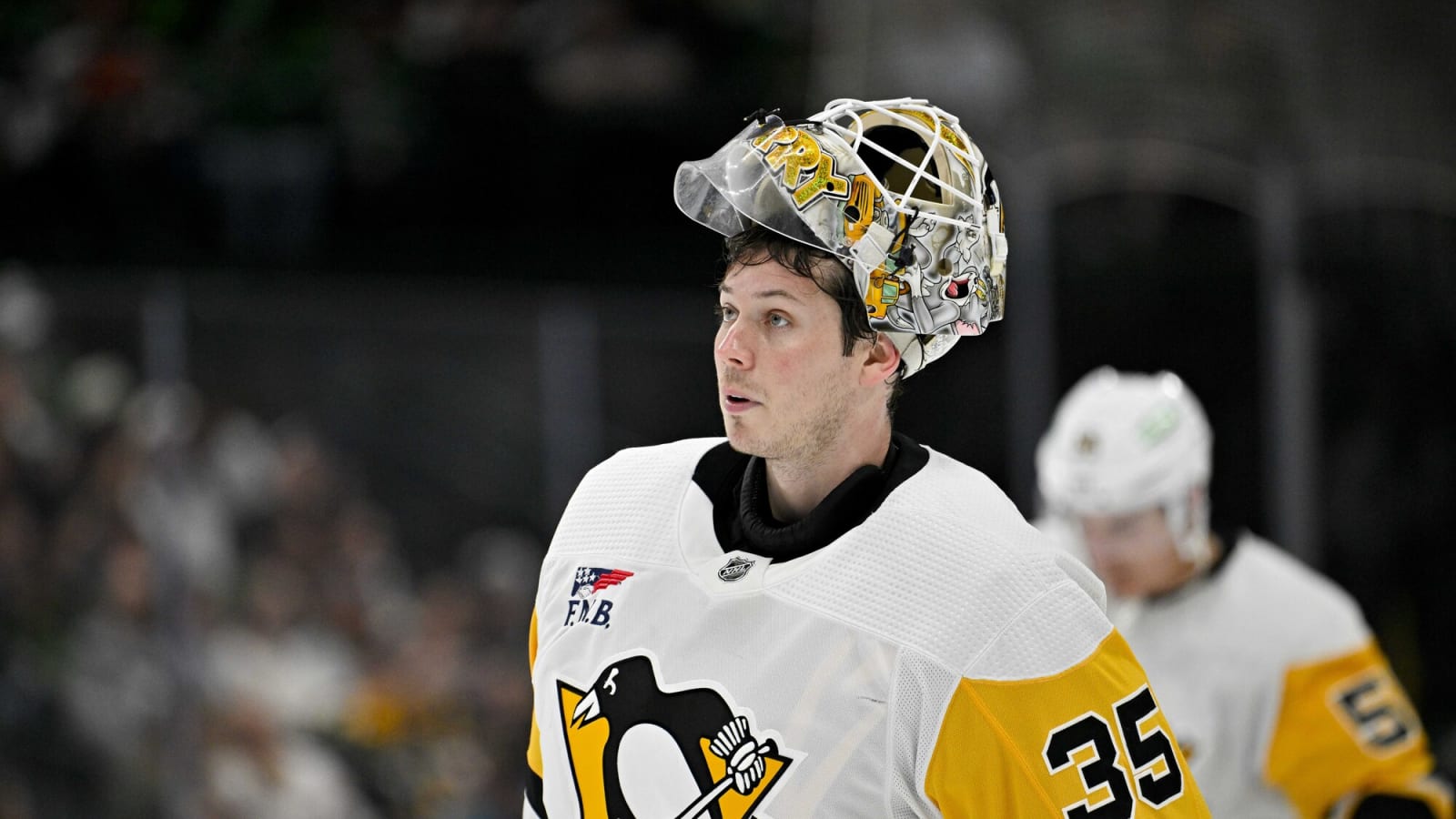
If professional sports teams were a direct democracy, Pittsburgh Penguins goalie Tristan Jarry probably would have been traded for a seventh-round pick or less this summer. However, fans don’t yet get to run their favorite teams with American Idol-style voting. So, as goalies dominated NHL trade rumors, Penguins president of hockey operations/GM Kyle Dubas acted appropriately and stood down.
In fact, it wasn’t until mid-June that Dubas re-signed backup/1A goalie Alex Nedeljkovic to a two-year, $5 million contract.
The full context of the Penguins’ goalie situation seemed set. Jarry, 29, was very good for most of last season until he was part of the Penguins’ later-season nosedive. Nedeljovic, 28, experienced a career resurgence, elevating himself from backup to a 1A-type goalie. He then started the final 14 games of the season during the Penguins’ frantic charge for the final playoff spot, which was exciting but too little, too late.
Top goalie prospect Joel Blomqvist had a stellar year with the Wilkes-Barre/Scranton Penguins, posting a .921 save percentage. Dubas rolled the red carpet for Blomqvist to join the NHL ranks this season if he could also be rock-solid in the AHL playoffs.
Blomqvist was not sharp in the postseason, and eventually, Dubas and crew decided to re-sign Nedeljkovic to give Blomqvist “time to breathe.”
There were three goalies at different stages of their careers: one starter, one sidecar, and one prospect on the way. The goaltending was set, right?
Wrong.
Poor Taylor Gauthier seems to be the forgotten man. Gauthier, 23, performed well backstopping the Wheeling Nailers of the ECHL with a .923 save percentage. He figured to become the WBS backup behind Blomqvist.
On April 29, Dubas signed 25-year-old former Detroit Red Wings sixth-round pick Filip Larsson. After a short stint in North America at the ECHL and AHL levels prior to the COVID rampage, Larsson returned home to Sweden and the Elite League without returning. Last season, the 6-foot-2 goalie posted save percentages above .920 with Leksands IF.
It would appear Larsson and Gauthier would battle for the second chair in WBS.
Wrong again.
On Tuesday, the Penguins completed their coup by signing 2022 fourth-round pick Sergei Murashov. The Russian goalie was a late addition to Development Camp in early July, and now he’s coming to North America. The sparkling goalie has grown a couple of inches since his draft day (or is at least listed as such) to 6-foot-2.
He’s also a rapidly rising star in the prospects world, posting a .930 save percentage in Russian juniors and a .925 stopper rate in six KHL games.
That Murashov, 20, played in the KHL is a significant piece of the puzzle. He’s already played in what is arguably the second-best league in the world against professionals, including former NHL players. And he performed quite well.
Pittsburgh, meet Sergei Murashov
pic.twitter.com/6dtGzL5FlW
— ChelPenguins (@ChelPenguins) July 30, 2024
Penguins Goalie Depth Chart
It seems like the world is coming full circle for Jarry, who was the Penguins’ 2013 second-round pick (44th overall). However, 2012 fourth-rounder Matt Murray beat him to WBS by a year, and the two shared the net in 2015-16 as Murray leaped the NHL. Jarry was caught behind starting goalies Murray and Marc-Andre Fleury until Murray elbowed past Fleury to take the net in 2017, and the Penguins said goodbye to Fleury via the Vegas Expansion Draft.
The Penguins haven’t had a pair of legitimate goalie prospects since. Jarry was once at the bottom of that totem pole pushing upward, but now he is at the top pushing down.
The questions are significant. Which goalie will emerge from the WBS Penguins faster? Could Murashov bolt past Blomqvist, quickly making the leap and forcing a Penguins trade? Will Blomqvist solidify his game, smoothing out those little rough patches that ultimately led to the team re-signing Nedeljkovic, and be ready in-season–forcing a Penguins trade?
What of Larsson? He probably didn’t sign a contract to play in Wheeling. What of Gauthier? He’s put in his time and deserves an AHL chance.
A Jarry trade seems more likely by the day. PHN has previously opined that next summer would be the appropriate time after Blomqvist has another year of maturation. However, Murashov wrecks that timeline as both Blomqvist and Murashov need playing time.
However, the offseason is essentially over. Teams made their moves. The LA Kings took on Darcy Kuemper and his somewhat onerous contract in the Pierre-Luc Dubois trade. The New Jersey Devils and Ottawa Senators made big splashes on the trade market, getting Jacob Markstrom and Linus Ullmark, respectively.
There might be a few teams in the league that could use a goalie upgrade, such as the Chicago Blackhawks or San Jose Sharks, but they also lack the urgency given the varying states of their rebuild.
Yet, it now seems inevitable. For the direct democracy crowd, the clock is ticking. Murashov’s arrival makes a Jarry trade far more likely, and it seems a matter of when, not if.
I mean, did you see those saves by Murashov?
More must-reads:
- Senators take major step toward new stadium
- Perhaps Superman Paul Skenes has found his kryptonite
- The 'American League WAR leaders' quiz
Breaking News
Trending News
Customize Your Newsletter
 +
+
Get the latest news and rumors, customized to your favorite sports and teams. Emailed daily. Always free!
TODAY'S BEST
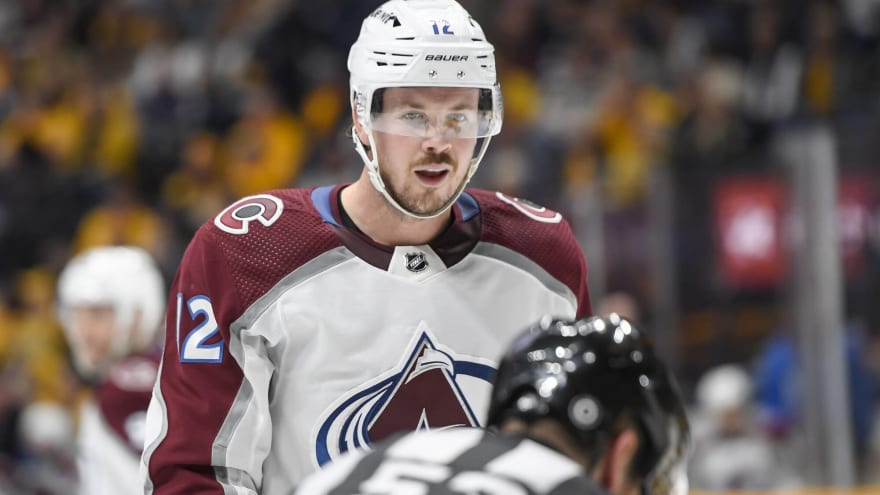
Arbitrator rules in favour of Flyers in grievance filed on termination of Ryan Johansen’s contract
An arbitrator has ruled in favour of the Philadelphia Flyers in the grievance filed by the NHL Player’s Association in regards to the termination of Ryan Johansen, according to TSN insider Darren Dreger. This is set to end a process that began a year ago when the Flyers had terminated the final year of Johansen’s eight-year contract with an $8 million cap hit. Philadelphia was only on the hook for $4 million of that contract, as the Nashville Predators had retained the other half of it when they dealt him to the Colorado Avalanche during the 2023 offseason, but after a “material breach”, the Flyers opted to terminate it. Then in September 2024, the NHLPA filed a grievance on behalf of Johansen over the decision to terminate the contract. Johansen didn’t play a game for the Flyers after he was acquired at the 2024 trade deadline due to a hip injury. Philadelphia wanted to waive him after acquiring him, but couldn’t because of the injury. Johansen’s agent, Kurt Overhardt, released the following statement at the time of the termination of the contract, stating his displeasure about the Flyers’ decision. “Ryan Johansen has a severe hockey injury that requires extensive surgery which has been scheduled,” said Overhardt. “Since being traded to the Philadelphia Flyers, Ryan has worked in good faith with the club, its medical staff and authorized third-party physicians. The Flyers’ intent to terminate Ryan’s contract is disappointing.” At this point in time, both the Flyers and Predators still have the cap space free to take on Johansen’s cap hit if needed. Nashville has about $9.3 million in cap space, while Philadelphia will have around $6.5 million between the roughly $370,000 in cap space now and Ryan Ellis’ contract that will go on LTIR at the start of the season. According to Dreger, Johansen is currently rehabbing the hip injury post-surgery. He’s been a free agent since the termination, having not signed with a team in 2024-25. Johansen had 13 goals and 10 assists for 23 points in 63 games in the 2023-24 season, all coming with the Avalanche.

Former crew chief frustrated by the 'ridiculous' racing at Watkins Glen
It is no secret that NASCAR's current road-course package has not been very good. Aside from the mile-and-a-half tracks that were once the least competitive and exciting in the series, those races are the rare bright spot for the Next Gen Car since its inception in 2022. Shane van Gisbergen drove away to an 11.1-second win over Christopher Bell in Sunday's race at Watkins Glen and set multiple records in the process. While the racing was not particularly exciting, that was not what left former crew chief and current analyst Steve Letarte frustrated the most following the weekend. A recurring issue in each race over the weekend was drivers utilizing the runoff areas around the track and not staying on the traditional racing surface, which ultimately led to some crashes in Saturday's Xfinity race. "So, I hate track limits that have to be officiated," Letarte said on "Inside the Race." "Because I like tracks that you should just stay on the track. I didn't think it mattered. Now, I am team get-them-back-on-the-race-track-at-Watkins-Glen. I don't love the Watkins Glen that I see. ... I think Turn 1 is not as great of a corner with no exit respect or responsibility. You just blow the exit. I think the carousel is a much easier corner, being able to just go driver's left. "I also think Turn 6 is going — let me add, that I think the (Connor) Zilisch, SVG wreck between the last two corners (in the Xfinity Series race) happened because they left the track, and the Austin Hill wreck with Michael McDowell happened off the race track. Now, both could have been avoided, we can talk about who's at fault. What I'm saying is, I've never driven a lap at Watkins Glen. I can analyze what happens between the white lines." This comes one year after rumble strips were placed in Turn 1 to keep drivers from using the runoff area, and that clearly has not worked. As the field has got closer together, using up all the track has become a common way for drivers to establish momentum, especially as they prepare for the right-hander going into The Esses at Watkins Glen. The bottom line is NASCAR's road-racing product needs to get better and Letarte wants to see race cars "stay on the race track because I think it will be a better race." Van Gisbergen's historic dominance certainly does not help, but the overall road course product is not great. Whether NASCAR makes some changes to the runoff areas and enforces track limits remains to be seen, but that still may not be the biggest issue if the racing does not improve.

Steelers' Ben Roethlisberger Thinks It Is Clear Preseason Hero Will Be Playing Elsewhere In 2025
The Pittsburgh Steelers played their first preseason game of 2025 on Saturday, and the organization was able to beat the Jacksonville Jaguars by a score of 31-25. The offense looked surprisingly good in the game, although it was mostly backups playing in the contest outside of the offensive line. The passing game was efficient, and both Mason Rudolph and Skylar Thompson looked good in the game. Logan Woodside came in at the end, but he didn't attempt a pass. The offensive player of the night was certainly Thompson, who was the fourth quarterback on the depth chart before Will Howard got hurt. Thompson is certainly on the outside looking in when it comes to the final roster, but his impressive performance during the first week of the preseason likely caught the eyes of some other teams around the NFL. Ben Roethlisberger spoke about the game on the most recent episode of Footbahlin With Ben Roethlisberger, and he shared that he thinks the quarterback could end up elsewhere. "I don't think the Steelers are going to keep four quarterbacks," Roethlisberger said. "Let's be honest. I think he is playing himself into like a really legit chance for a backup job somewhere on a team. Which is what you want." Thompson is going to need to continue to stack good performances in the preseason, and if he does, the Steelers may have the chance to trade him before cutting down to the final roster at the end of August. It is known that the top two quarterbacks on the roster are Aaron Rodgers and Rudolph, with Howard being right behind them. Thompson will likely end up elsewhere, it just depends on how that comes about. Other teams across the league probably know that the Steelers do not have the intention to keep Thompson around for the regular season, and that could make navigating a potential trade difficult. However, if there are multiple teams that are going to be interested in Thompson's services, one might be willing to trade a Day 3 draft pick in order to get him. The Steelers would not get much in any deal surrounding Thompson, but an additional sixth or seventh round pick for the 2026 NFL Draft would not hurt. No organization would trade for Thompson based off just one good preseason performance, especially with how the rest of the quarterback's career has gone when he was with the Miami Dolphins. He has struggled when he has been asked to start in games, but maybe he has turned over a new leaf that might make him valuable as the top backup for another organization. Another strong performance or two should definitely put him on the radar of quarterback-needy teams. Steelers' Skylar Thompson Could Have A Few Potential Destinations When looking around the league and trying to figure out what teams might be interested in bringing in Thompson, it is hard to ignore a team like the New Orleans Saints. The entire quarterback room in New Orleans has limited experience with Spencer Rattler and Jake Haener barely ever seeing the field. Rookie Tyler Shough is an interesting prospect, but there is no telling how he will play. The Saints may want to consider Thompson, at the very least to bring in someone who has legitimate playing experience. Another team to consider would be Thompson's former team, the Dolphins. Tua Tagovailoa has struggled with injuries, and neither Zach Wilson or Quinn Ewers looked great in the team's first preseason game. A reunion could be in play as Thompson has a handle on the offensive system and has a decent amount of game experience playing in Miami. Another option is the New York Jets, as Tyrod Taylor is going through an injury and the rest of the room has a lot of question marks.

Six Major Toronto Raptor Storylines Heading into the 2025-26 NBA Season
Preseason rarely decides a season, yet it often reveals trends coaches and players embrace early. This preview matters for Toronto because a young roster is now defining roles and habits. Last year closed with optimism, tempered by lessons about process, health, and late-game execution issues. Six storylines stand out, tying together personnel returns, development surges, and evolving tactical preferences ahead. They offer a framework for what progress should look like when games start counting again. Fans should watch integration, depth, and defense, while noting how structure translates into efficiency nightly. Each section below traces a discrete focus, grounded in the team’s recent numbers and context. The picture that emerges is pragmatic, cautious about conclusions, yet clear about the necessary steps ahead. 1. Ingram’s Health and Fit With Toronto’s Core Toronto’s most significant variable is Brandon Ingram returning from the ankle sprain that stalled momentum. He received a plasma-rich platelet injection on April 9, with progress rechecked in May. Before the trade, he averaged 22.2 points, 5.6 rebounds, and 5.2 assists for New Orleans. He also signed a three-year, $120 million extension, underscoring organizational belief in his fit. Preseason minutes should emphasize chemistry with Scottie Barnes, Immanuel Quickley, and RJ Barrett on ball. Spacing, delay actions, and handoffs can spotlight his playmaking without stalling possessions. Medical clearance matters, but role clarity matters more for smoothing touches and decision-making tempo overall. If rhythm appears early, lineups featuring Ingram and Barnes could punish switches and rotations consistently, a factor sure to draw attention from odds makers and fans tracking lines on FanDuel Sportsbook. If timing lags, Toronto can throttle usage, preserving health while protecting core offensive principles early. 2. Poeltl’s Paint Protection and Coverage Tweaks Jakob Poeltl remains the stabilizer, anchoring paint coverage and orchestrating actions from the elbow every night. Early last season, he was asked to play higher in pick-and-roll, with mixed outcomes. Later, he dropped more often, protecting the rim and closing cracks more comfortably. Coaches leaned on his reads, toggling sets to lift shot quality for teammates. Poeltl, 29, is the oldest signed player, giving this group a needed veteran anchor presence. During the NBA preseason, the Raptors should frequently experiment with coverage depth, weakside tagging rules, and early-clock rim runs. His health matters, given a late-season metacarpal contusion that warranted careful management recently. If he anchors drop while wings chase over, rotations can tighten without sacrificing rebounding positioning. If the staff prefers higher coverage, second-line timing, and stunts demand crisp preseason reps, together. 3. Barnes’ Two-Way Ascension and Leadership Test Scottie Barnes enters camp as the fulcrum, balancing usage, efficiency, and defensive responsibility this preseason. He averaged 19.3 points, 7.7 rebounds, and 5.8 assists across 65 appearances last season. Toronto’s defense surged to second after the All-Star break, settling 15th on aggregate. Barnes anchored coverages, switching, rotating, and cleaning mistakes while energy stayed remarkably consistent. Coaches experimented with heavy on-ball responsibility, which produced lessons alongside occasional downturns in production. Preseason will spotlight decision speed, screening angles, and when to attack versus facilitate reads. Barnes also finished the year managing a metacarpal contusion, so the workload should be scaled prudently early. Leadership questions become far easier to answer if efficiency rises while defensive impact holds. If not, guard pairings and late-clock structure must support him without blunting aggression or creativity. 4. Rajakovic’s System: Process Gains vs. Scoring Output Darko Rajakovic kept modern principles, building motion, delay actions, and handoff sequences into habits. Toronto threw the sixth-most passes and ran the third-most cuts, emphasizing continual movement across possessions. Isolations were the fewest in the league, with handler-finished pick-and-rolls the fourth-fewest. Handoffs were frequent, ranking eighth, while Poeltl toggled sets cleanly to lift shot quality. Results lagged, with the offense finishing 26th, after placing 24th the prior season overall efficiency. Clutch stretches hurt further, as the group posted the second-worst overall net rating late league-wide. Preseason focus should test counters that preserve movement while generating cleaner pull-up spacing windows. Health for Immanuel Quickley, Barnes, and Ingram could turn process gains into actual scoring. Bench lineups must also sustain tempo, so structure persists even during substitution waves consistently. 5. Rookies and Newcomers Pushing a Defensive Identity Toronto doubled down on defense, adding prospects who can pressure, swarm, and finish possessions. Collin Murray-Boyles arrived ninth overall, after averaging 1.5 steals and 1.3 blocks for South Carolina. At the combine, he measured 6-foot-6.5 with a 7-foot-0.75 wingspan and weighed 239 pounds officially. Second-rounder Alijah Martin posted 1.5 steals, measured 6-foot-1.5 without shoes, and weighed 208 pounds. Undrafted guard Chucky Hepburn signed a two-way contract after winning ACC Defensive Player honors. He averaged 2.4 steals as a senior, bringing on-ball toughness and turnover creation upside. Returnees Ja’Kobe Walter, Jonathan Mogbo, and Jamal Shead add continuity from last year’s rookie minutes. Toronto allowed 115.2 opponent points per game, ranking 18th, and addressed that with real depth. 6. Raised Expectations After a Rebuild Year Last season ended with a 30–52 record and a clear developmental mandate from leadership. Toronto finished seven games back of the final play-in, which strategically aligned with rebuilding priorities. The organization framed the year as the first phase in a three- to five-year project roadmap. That approach yielded a high pick, adding Murray-Boyles and retaining Brandon Ingram on extension terms. Players voiced playoff aims, but healthy availability and consistency must precede any ambitious targets. Preseason becomes a checkpoint, translating optimism into matchups, substitution patterns, and reliable closing groups nightly. What to Watch as Roles Solidify If these threads align, optimism turns concrete, and opening weeks become a launchpad rather than a tease: Use preseason to track availability updates, especially Ingram’s ankle and Barnes’ workload ramp timelines closely, Note how spacing evolves in delay actions when Quickley and Ingram effectively share initiator duties, Watch Poeltl’s coverage depth, then check whether wings sync rotations without conceding corner threes frequently, Track steals, deflections, and on-ball pressure from Murray-Boyles, Martin, and Hepburn in bursts against starters, Assess late-clock structure, given last year’s second-worst clutch net rating under pressure and pace control, Consider organizational signals, since leadership changed following the draft. That shaped accountability pathways for players and staff, Finally, substitution patterns should be monitored; a sustained tempo should survive bench minutes without drift or slippage. A Thrilling Raptors Preseason Ahead The Raptors enter the preseason with more clarity than a year ago but no shortage of questions to answer. Health for Brandon Ingram and Scottie Barnes, the integration of defense-first rookies, and fine-tuning Darko Rajakovic’s system will all shape how quickly Toronto can turn optimism into results. If depth, defensive buy-in, and late-game execution align, this young roster has a genuine chance to turn a rebuilding year into the foundation of a playoff push.
